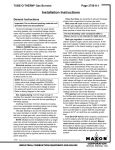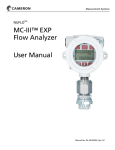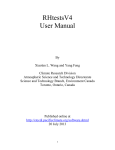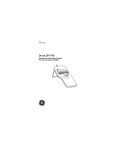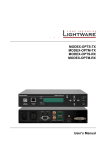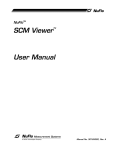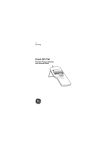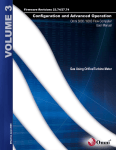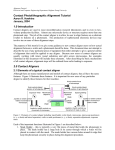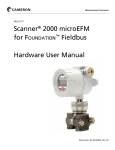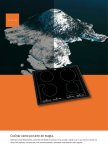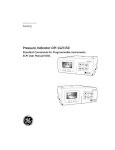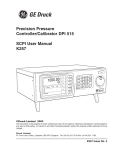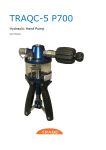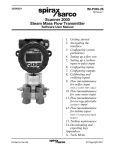Download NUFLO DP Cone Meter User Manual
Transcript
NUFLOTM Differential Pressure Cone Meter User Manual Manual No. 85165000, Rev. 01 Important Safety Information Symbols used in this manual: This symbol identifies information about practices or circumstances that can lead to personal injury or death, property damage, or economic loss. WARNING This symbol indicates actions or procedures which if not performed correctly may lead to personal injury or incorrect function of the instrument or connected equipment. CAUTION Terms used in this manual: Note Indicates actions or procedures which may affect instrument operation or may lead to an instrument response which is not planned. Technical Support Contact Information: Cameron Measurement Systems 14450 John F. Kennedy Blvd. Houston, TX 77032 Phone: 1-800-654-3760; 281-582-9500 Fax: 281-582-9599 NuFlo is a trademark of Cameron International Corporation (“Cameron”). Copyright © 2007 Cameron International Corporation (“Cameron”). All information contained in this publication is confidential and proprietary property of Cameron. Any reproduction or use of these instructions, drawings, or photographs without the express written permission of an officer of Cameron is forbidden. All Rights Reserved. Printed in the United States of America. Manual No. 85165000, Rev. 01 April 2007 Table of Contents Section 1—General Description and Specifications......................................................................... 5 Introduction .............................................................................................................................................5 Applications ............................................................................................................................................5 Meter Components .................................................................................................................................5 Principles of Operation ...........................................................................................................................6 Meter Nameplate ....................................................................................................................................8 Section 2—General Installation Guidelines ....................................................................................... 9 Important Safety Information ..................................................................................................................9 Unpacking the Meter ..............................................................................................................................9 Assembling the System ..........................................................................................................................9 System Components ............................................................................................................................10 Differential Pressure Transmitter ................................................................................................... 11 Shut-Off Valves .............................................................................................................................. 11 Valve Manifolds.............................................................................................................................. 11 Thermo well or Thermocouple ....................................................................................................... 12 Process Piping Considerations.............................................................................................................12 Impulse Tubing Size Selection....................................................................................................... 12 Pipe Material .................................................................................................................................. 12 Pipe Length and Configuration ...................................................................................................... 13 Extreme Temperature Applications................................................................................................ 13 Best Practices for Installing the NuFlo Cone Meter..............................................................................14 Flow Run Requirements................................................................................................................. 14 Meter Orientation and Transmitter Position ................................................................................... 14 Pressure Tap Location ................................................................................................................... 14 Impulse Tubing............................................................................................................................... 15 Installation Checkpoints for the Transmitter .........................................................................................16 Section 3—Meter Installation for Liquid Service............................................................................. 17 Installation Options ...............................................................................................................................17 Meter Orientation ........................................................................................................................... 17 Pipe Orientation ............................................................................................................................. 17 Wall Taps ....................................................................................................................................... 17 Condensate Chamber (Drip Pot) ................................................................................................... 17 Horizontal Meter Installation .................................................................................................................17 Bubble Pot Installation (Optional) .................................................................................................. 18 Vertical Meter Installation .....................................................................................................................19 Vertical Meter with Wall Taps ...............................................................................................................20 Transmitter Calibration .........................................................................................................................21 Section 4—Meter Installation for Gas Service................................................................................. 23 Installation Options ...............................................................................................................................23 Meter Orientation ........................................................................................................................... 23 Impulse Tube Orientation............................................................................................................... 23 Condensate Chamber (Drip Pot) ................................................................................................... 23 Horizontal Meter Installation .................................................................................................................23 Drip Pot Installation (Optional for Wet Gas)................................................................................... 24 Vertical Meter Installation .....................................................................................................................25 Transmitter Calibration .........................................................................................................................26 April 2007 Page iii Table of Contents Section 5—Meter Installation for Steam Service............................................................................. 27 Installation Options ...............................................................................................................................27 Meter Orientation ........................................................................................................................... 27 Impulse Tubing Orientation ............................................................................................................ 27 Condensate Chamber .................................................................................................................... 27 Horizontal Meter Installation .................................................................................................................28 Vertical Meter Installation .....................................................................................................................29 Transmitter Calibration .........................................................................................................................30 Section 6—System Modifications ..................................................................................................... 31 Square Root Error.................................................................................................................................31 Gauge Line Error............................................................................................................................ 31 Elevation and Temperature Effects in Piping .......................................................................................31 Appendix A—Flow Measurement Theory and Equations ............................................................ A-1 Bernoulli Principle ............................................................................................................................... A-1 Table of Contents Page iv April 2007 Section 1 General Description and Specifications Introduction The NuFlo™ Differential Pressure Cone Meter is a process control and multi-fluid meter that uses differential pressure to provide accurate, repeatable and cost-optimized measurement solutions. The NuFlo Cone Meter produces a differential pressure which is read by a differential pressure or multi-variable transmitter. The NuFlo MVX-II multivariable transmitter and the NuFlo Scanner 2000 microEFM, which feature an integral multi-variable transmitter, are among the devices that are compatible with the Cone Meter. The method used to connect the transmitter to the meter varies, depending on the type of product measured and available space for mounting the meter. This user manual provides installation instructions and piping diagrams for using the Cone Meter in liquid, gas, and steam applications. Applications The NuFlo Cone Meter is designed to work in unprocessed and processed applications, and is ideal for upstream, midstream and downstream flow metering applications that present a wide range of measurement challenges. The NuFlo Cone Meter is ideal for low-pressure coalbed methane wellhead and field applications, compressor anti-surge control, and test separator applications. Meter Components The meter comprises three primary elements, as shown in Figures 1.1 and 1.2: • a meter body or tube with or without flanges • a cone assembly, either fabricated or machined from a solid piece of metal, positioned in the center of the meter tube • a pair of pressure taps—a wall tap upstream and an integral sensing tap downstream—for reading the differential pressure in the center of the meter tube. (Alternately a downstream tap may be used under certain process measurement conditions.) The meter can be manufactured from various materials (carbon, stainless, or duplex stainless steel) to meet the specific requirements for metering steam, air, natural gas, digester gas, nitrogen, ethanol, and a host of liquids from crude oil to waste water. April 2007 Page 5 Section 1 Figure 1.1—Basic components of the NuFlo Cone Meter The NuFlo Cone Meter has no moving parts, and is designed such that there are no areas of stagnation where trash or fluid particles can lodge. Accordingly it is virtually maintenancefree. Principles of Operation The NuFlo Cone Meter generates a differential pressure that can be used to calculate fluid flow rate. A transmitter measures the differential pressure and outputs an integrated electronic signal, typically via Modbus or a 4-20 mA output, to a flow computer or other process controller for interpretation and readout. For compressible fluids, line pressure and temperature measurements are required for accurate flow rate calculations as well as compensation for the adiabatic change in the expansion factor. As fluid flowing through the pipe flows around the cone, a pressure drop occurs. The static line pressure (P1) is measured via a wall tap located just upstream of the cone (Figure 1.2). Pressure is also measured via a sensing tap that is connected to the cone and measures pressure at a point immediately downstream of the cone (P2). The fluid flow rate is calculated using the difference between the two pressures using variations of the standard differential pressure flow measurement principles. Section 1 Page 6 April 2007 Figure 1.2—NuFlo Cone Meter, cutaway view The shape of the meter cone reshapes the fluid velocity profile upstream of the meter cone, conditioning flow naturally and eliminating the need for traditional flow conditioners. As a result, the NuFlo Cone Meter can be installed in shorter meter runs than those required by conventional differential pressure meters and a high degree of accuracy is ensured even under extremely disturbed flow conditions. Table 1—Performance Characteristics and Specifications Accuracy Turndown Repeatability Installation Requirements up to ± 0.5% of rate 10:1 ± 0.1% 0 - 5 pipe diameters upstream (5 diameters if a gate valve is used) 0 - 3 pipe diameters downstream Differential Pressure Limit > 0.1 WC (minimum 1 in. WC preferred but the Reynolds number requirements must be met 50 -200 WC (consult factory for higher DPs) >8000 Re see Appendix A for the appropriate expansion factor equations with respect to the meter geometry and process application gases, vapors, or liquids horizontal or vertical varies with type of product measured (see Figure 2.4, page 15) Cd is unique to each meter and must be determined by calibration Differential Pressure Recommended Reynolds number (Re) Y factor (gases only), as installed in various NuFlo computers Fluids Meter Orientation Tap Location Coefficient of discharge (Cd) April 2007 Page 7 Section 1 Beta Range End Connections Tube Design 0.45 to 0.85 standard - (0.05 increments) weld neck flanges RTJ flanges slip-on connections Threaded (fractional inch sizes) flangeless (welded in line) welded construction (1/2-in. and greater diameters) carbon, stainless, or duplex stainless steel The Reynolds number typically ranges from 8500 to above 5 million. With special calibration, the Cd can be calibrated to a lower Reynolds number. Differential pressures can range from less than 1 in. WC to more than several hundred inches WC to facilitate large turndowns. (A minimum differential pressure of 1 in. or greater is recommended to ensure a stable and low-noise differential pressure signal, due to transmitter hysteresis.) Meter Nameplate The nameplate affixed to the NuFlo Cone Meter (Figure 1.3) contains specifications for the meter, including the coefficient of discharge (Cd). The calibrated Cd, which is unique to each meter, offers traceability for the accuracy of the meter. The direction of flow is also indicated on every nameplate for easy reference during installation of the meter. Figure 1.3—Sample nameplate Section 1 Page 8 April 2007 Section 2 General Installation Guidelines Important Safety Information Installation, inspection, and maintenance of the NuFlo Cone Meter must be performed by authorized and trained personnel who have a working knowledge of piping configurations. Never open a manifold valve or flange unless you have first verified that the system is completely depressurized. WARNING During liquid or wet gas service, open valves very slowly to avoid slugging in the meter run. Always use proper procedures and equipment for lifting and moving the NuFlo Cone Meter to avoid risk of injury. Secure all connections properly before starting up a system. Keep a safe distance away from the process upon startup. Be mindful of static electricity generated by insulated footwear etc., and always ground yourself before touching pipes in the hazardous area where flammable gas is being metered. Unpacking the Meter All NuFlo Cone Meters are securely packed to help prevent damage during shipment. Inspect the packing list on receipt of the device and report any discrepancies immediately. Assembling the System The NuFlo Cone Meter alone cannot measure flow. It is intended for use with instrumentation such as a transmitter or flow computer. The installation usually comprises a manifold system for isolating the process fluid and allowing maintenance and calibration of the transmitter. April 2007 Page 9 Section 2 Figure 2.1—Typical components of a NuFlo Cone Meter system System Components A transmitter, valve manifold, shut-off valves, and impulse tubing are typically required for the operation of a NuFlo Cone Meter. If the meter is used to measure steam, a condensate pot may also be required. Before installing a NuFlo Cone Meter, review the following installation tips: • • • Make sure the piping, tubing, or manifold installed between the NuFlo Cone Meter and the transmitter complies with national and local standards, regulations, and codes of practice to ensure safe containment of fluid. A hydrostatic or pneumatic test may be required for piping systems to prove the integrity of the pressure-containing components. In installations that are prone to plugging, a rod or other device may be used to remove materials blocking the impulse tubing. WARNING Section 2 Never use a rod to clean out process lines in high-pressure applications or where high temperatures (e.g. steam) or dangerous fluids are being measured. The meter run should be isolated and completely depressurized before inserting a rod into an impulse tube. Page 10 April 2007 Differential Pressure Transmitter A differential pressure transmitter records the differential pressure signal generated by the cone meter and provides an analog or serial output to a flow computer or data control system. The transmitter(s) selected for an installation must be appropriate for operating conditions of the process in terms of both accuracy and safety. DP devices must be zeroed following installation. The procedure varies somewhat for liquid, gas, and steam applications. Procedures are provided for each application in Sections 3, 4, and 5, respectively. Shut-Off Valves Choose a block valve that is rated for the operating pressure of the pipe in which it will be installed. Where dangerous or corrosive fluids or gases like oxygen are likely, the block valve and packing must provide ample protection. The valves must not affect the transmission of the differential pressure signal. Install block valves next to the NuFlo Cone Meter pressure taps. Never use a globe valve for differential pressure transmission lines. Figure 2.2—Block valves Valve Manifolds A 3-way or 5-way valve manifold isolates the transmitter from the process lines (5-valve manifolds recommended). They allow the operator to calibrate the transmitter without removing it from the impulse tubing, drain the transmitter and impulse tubing or vent it to atmosphere. Valve manifolds must be oriented according to the manufacturer’s instructions to prevent trapping of air or liquid. April 2007 Page 11 Section 2 Figure 2.3—A 5-way manifold block mounted with a multi-variable transmitter Thermowell or Thermocouple Flow measurement calculations for differential pressure devices require temperature and pressure measurement. Generally, a thermowell with an RTD installed is mounted downstream of the meter within 3 pipe diameters of the meter. Alternatively, a thermo-well can be installed inside the meter body upstream of the cone and the meter calibrated with it in position. For installations where temperatures are stable, a thermocouple or temperature probe may be attached to the outside of the upstream piping and covered with insulation. Impulse Tubing Considerations Before connecting impulse tubing between the NuFlo Cone Meter and the transmitter, consider the following tips for optimizing your system’s measurement accuracy. In a welldesigned installation, fluids will drain freely from the process lines and gases will vent to the atmosphere. Tubing Size Selection Impulse tubing (that connects the DP Cone meter tap holes to the transmitter) diameters vary with service conditions. The bore should be no smaller than ¼ in. (6 mm); a minimum diameter of 3/8 in. (10 mm) is recommended. The internal diameter (ID) must not exceed 1 in. (25 mm). For steam applications, the ID should be 3/8 in. (10 mm) to 1 in. (25 mm). In most process control applications, the primary concern is flow reliability. If the pressure taps or the impulse tubes become plugged, the reliability of the flow measurement is lost. This creates a safety risk and the cost incurred in regaining control can be substantial. High reliability is required for flow signals used in process safety management. A minimum tubing ID of 5/8 in. (16 mm) is recommended in industrial applications. For high temperatures in condensing vapor service, 1 in. (25 mm) is recommended. Tubing Material Most instrument tubing is 316 stainless steel. However, duplex steel may be preferred for offshore applications where corrosion protection against saltwater is needed. Section 2 Page 12 April 2007 Tubing Length and Configuration For best performance, adhere to the following recommendations for tubing length and orientation: • • • • • Tubing length must be short enough to ensure a high degree of accuracy, and long enough to ensure proper cooling of high-temperature fluids before they reach the transmitter. Make sure the installation permits access to the impulse tubes, valves, valve manifolds, and transmitters. Limit the number of fittings and avoid long tubing sections, which can impair measurement accuracy and increase the risk of plugging. Avoid changes in tubing elevation and fluid temperature. Differences in elevation will cause a difference in the hydrostatic pressure of the liquid column in the process lines. Temperature differences will cause a difference in the density of the fluids in the two lines, which will change the amount of pressure generated. Both can result in inaccurate differential pressure measurements. Fasten the process lines together, if possible. Install process lines so that they slope in only one direction (up or down). If piping must slope in more than one direction, do not allow more than one bend and install a liquid or gas trap, as applicable. A liquid trap should be installed at the lowest point in a gas service installation. A gas trap should be installed at the highest point in a liquid service installation. Extreme Temperature Applications Steam temperatures can reach 1500°F (815°C), well exceeding the temperature rating of a standard DP transmitter (200°F or 93°C). A condensate chamber can be used to isolate the transmitter from the extreme temperatures. Alternatively, a long tube section can be installed to allow the fluid to cool before it reaches the transmitter. As a general guideline when planning tubing lengths for temperature control, run tubing horizontally where possible, and allow for a temperature drop of 100°F (38°C) per foot (305 mm) of tubing. This is merely a guideline, however; the operator is still responsible for ensuring that the temperature at the transmitter does not exceed the transmitter’s rating for the environmental conditions present. In extreme cold temperature installations, thermal insulation and/or “heat tracing” of process lines may be necessary. The amount of heat used must be carefully calculated to prevent liquids from vaporizing and prevent condensable vapors from producing unwanted condensation. Fastening process lines together is recommended for keeping process lines at approximately the same temperature. Providing a temperature-controlled environment for the transmitter also helps ensure accurate metering in locations where extreme temperatures are likely (such as on offshore platforms or in desert installations). April 2007 Page 13 Section 2 Best Practices for Installing the NuFlo Cone Meter Note Read the best practice recommendations below in their entirety before installation of the NuFlo Cone Meter. The basic steps for installing a NuFlo DP Cone Meter system are described as follows. 1. Install the meter in the meter run in accordance with the flow run requirements below. 2. Secure the manifold to the meter taps. 3. Connect the differential pressure transmitter to the manifold, observing the recommended guidelines below for pressure measuring tubes. 4. Connect the transmitter to the flow computer according to instructions in the transmitter user manual. 5. Zero the transmitter. Flow Run Requirements The NuFlo Cone Meter should be installed with zero to five pipe diameters of straight run upstream of the meter and zero to three pipe diameters downstream. The meter can be used in pipelines that are slightly larger than the meter tube; however, if the meter tube is larger than the pipeline, operators should contact NuFlo for installation requirements. This is usually determined before supply according to application and the degree of accuracy and performance required. Meter Orientation and Transmitter Position The NuFlo Cone Meter can be installed in a horizontal or vertical position. The location of the transmitter with respect to the meter should be based on the properties of the fluid or gas being measured (gas, steam, liquid, etc.) and the direction of flow through the pipeline. The direction of flow is clearly labeled on nameplate affixed to the body of every NuFlo Cone Meter shipped. The meter must be installed so that the static pressure tap (labeled P1 in Figure 1.2) is always upstream of the differential pressure tap. Pressure Tap Location Location of the static pressure and differential pressure taps will vary with the product flowing through the pipeline (liquid, gas, or steam) and the orientation of the meter (vertical or horizontal). For horizontal installations, the following installation guidelines apply: For measuring liquid, differential pressure taps should be located in the bottom half of the pipeline, between 4 o’clock and 5 o’clock positions, or between 7 o’clock and 8 o’clock positions. • For measuring gas, differential pressure taps should be located in the top half of the pipeline. For wet gas, taps should be located between the 10 o’clock and 2 o’clock positions to allow proper drainage of liquids present. • For steam, differential pressure taps should be located in the side of the pipeline. • Illustrations of typical piping configurations for liquid, gas, and steam are provided in Sections 3, 4, and 5, respectively. Section 2 Page 14 April 2007 Figure 2.4—Recommended tap locations for horizontal meter installations For vertical installations, the location of differential pressure taps is unrestricted, as long as the static pressure tap is upstream of the lower-pressure tap. Impulse Tubing Impulse tubing is used to connect the sensing taps of the cone meter to the manifold connected to the differential pressure transmitter. One section of tubing should connect the high-pressure tap to the high-pressure (static) side of the differential pressure transmitter; another section of tubing should connect the low-pressure tap to the low-pressure side of the differential pressure transmitter. • Impulse tubing should be installed with a gradient larger than 1/10 to help prevent undesirable fluids from being transferred to the differential pressure transmitter. • If tubing is installed in a horizontal orientation, install a gas/liquid separator device. • Avoid abrupt bends in impulse tubing. • If impulse tubing sections are long, use mounting brackets to support them. See also “Tubing Size Selection,” page 12. Never use excessive pressure or force when connecting impulse tubing to a differential pressure transmitter. WARNING If high-temperature fluids are likely to be encountered, make sure the impulse tubing is rated for the anticipated temperature range. CAUTION See Sections 3, 4, and 5 for installation procedures recommended for liquid, gas, and steam applications, respectively. Both horizontal and vertical meter orientations are discussed as appropriate for each application. April 2007 Page 15 Section 2 For additional installation information, refer to ISO 5167, or contact Cameron’s Measurement Systems Division. Installation Checkpoints for the Transmitter Before putting the NuFlo Cone Meter into service, verify that the transmitter is installed properly by reviewing the following checkpoints: • • • • • • • Is the transmitter full scale correct? Has the transmitter zero been checked and/or adjusted? Are the transmitter and flow computer set to the appropriate modes—linear or square root? Have the transmission lines to the transmitter been purged? Are there any leaks in the transmission lines? Is the manifold cross valve closed? Is the NuFlo Cone Meter high pressure port located upstream of the low pressure port? Section 2 Page 16 April 2007 Section 3 Meter Installation for Liquid Service Installation Options Meter Orientation NuFlo Cone Meters can be installed in a horizontal or vertical position. Horizontal is the standard orientation, however where space is very limited, a vertical position may prove to be the best option. Pipe Orientation The orientation of piping is dictated by the position of the meter, the type of product being measured, and for vertical meter installations, the direction of flow. When a vertical piping system is used, the operator must give special consideration to the piping configuration to prevent gas from being trapped in liquid differential pressure lines Wall Taps In extremely cold environments where there is a risk of product freezing in the process lines, the low-pressure sensing port connected to the cone meter can become plugged with ice (see P2 in Figure 1.2, page 7. In such installations, a wall tap may be installed downstream of the meter and used to measure the downstream pressure. This will allow the blockage to be removed without removing the meter from the meter run, but the meter run must be isolated and depressurized before attempting to clean out the blockage. Condensate Chamber (Drip Pot) The condensate chamber (drip pot) is a collection vessel to avoid gas bubbles in liquid instrument tubing. It should be mounted at the highest point in the impulse tubing between the cone meter and the DP transmitter. Horizontal Meter Installation For horizontal installations, pressure taps must be positioned 30° to 60° below the horizontal centerline (4 o'clock to 5 o'clock or 7 o'clock to 8 o'clock). Taps at the bottom of the pipe may become plugged with solids from the liquid; taps above the centerline can accumulate air or non-condensing gases. In liquid service, the connecting lines from the meter shall slope downward to the transmitter with no upturns or pockets. The minimum recommended slope for self-venting is 1 inch per foot. April 2007 Page 17 Section 3 Figure 3.1—Piping installation for liquid measurement with a horizontal meter Bubble Pot Installation (Optional) In liquid applications where the transmitter must be mounted above the metering line, gas or vapor in the liquid can collect at the highest point in the instrument tubing and give a false differential pressure reading. Bubble pots may be the only effective solution for such installations. The piping from the meter connects to the bubble pot anywhere between the 10 o’clock and 2 o’clock positions on a horizontal plane. Figure 3.2—Bubble pot installation for liquid service where transmitter must be installed above the meter run Section 3 Page 18 April 2007 Vertical Meter Installation In most process applications, the operator should assume that some level of gas or vapor exists in a liquid service, even if the liquid is water. As a result, the piping configuration must be designed to allow gas to rise back into the flow stream. The process piping should be extended horizontally a very short distance from the downstream tap and then sloped at a nominal 1-inch-per-foot angle to the top of the manifold block. The manifold block should be mounted horizontally below the upstream tap so that piping from the upstream tap to the manifold slopes downward also. When the process is turned off, particulates may fall into the low-pressure port. It is advisable to flush the low-pressure port with an inert fluid before starting the meter. CAUTION Figure 3.3—Piping installation for upward flow through a vertical meter Note: April 2007 While downward flow through a vertically oriented meter is suitable for a gas application, downward flow piping configurations that use the standard upstream and downstream pressure ports are not recommended for liquid applications due to the risk of trapping gas. For such applications, consider the use of a vertically oriented meter with wall taps, as described below. Page 19 Section 3 Vertical Meter with Wall Taps Both process lines should be extended horizontally for a very short distance, and then tubed downwards to a manifold block. The manifold block should be mounted horizontally below the bottom tap, and the transmitter should be mounted below the manifold block. Figure 3.4—Piping installation for upward flow through a vertical meter with wall taps Figure 3.5—Piping installation for downward flow through a vertical meter with wall taps Section 3 Page 20 April 2007 Transmitter Calibration Transmitters (differential pressure and/or multi-variable) should be calibrated according to the manufacturer’s recommendations, appropriate national or company standards and contractually agreed methodology. Consideration should be given to the service in which the NuFlo Cone Meter and transmitter are installed and operated. April 2007 Page 21 Section 3 Section 3 Page 22 April 2007 Section 4 Meter Installation for Gas Service Installation Options Meter Orientation NuFlo Cone Meters can be installed in a horizontal or vertical position. Horizontal is the standard orientation, however where space is very limited, a vertical position may prove to be the best option. Impulse Tube Orientation The orientation of impulse tubing is dictated by the position of the meter, the type of product being measured, and for vertical meter installations, the direction of flow. When a vertically oriented metering system is used, the operator must give special consideration to the tubing configuration to prevent liquid from being trapped in gas differential pressure lines in gas service installations Condensate Chamber (Drip Pot) The condensate chamber is a collection vessel that helps prevent liquid pockets from collecting in gas instrument tubing. Horizontal Meter Installation The pressure taps on the NuFlo DP Cone Meter should be between the horizontal centerline and the top of the pipe (3 o'clock to 12 o'clock or 9 o'clock to 12 o'clock). If the fluid is a "wet gas" (i.e., a gas containing small quantities of liquids), the pressure taps should be situated in a vertical position (12 o’clock) to allow all liquids to drain away from the transmitter (Figure 4.2). If the connecting tubing extending from the cone meter to the transmitter is not installed in a vertical position, it should slope upward (at least 1 inch per foot) to ensure proper drainage. Figure 4.1—Piping installation for dry gas measurement with a horizontal meter April 2007 Page 23 Section 4 Figure 4.2—Piping installation for wet gas measurement with a horizontal meter Drip Pot Installation (Optional for Wet Gas) If drip pots are used, they should ideally be mounted immediately following the shutoff valves installed near the upstream and downstream pressure taps of the meter. For wet gas applications, the piping from the meter connects to the condensate chamber in a 3 o'clock or 9 o'clock position on a horizontal plane. The chambers are positioned vertically so that the meter connection and instrument connection points are at the top and drain points are at the bottom of the chambers. Figure 4.3—Condensation chamber (drip pot) installation Section 4 Page 24 April 2007 Vertical Meter Installation When the meter is installed in a vertical position, the operator must take special care to ensure that no trap forms in the downstream tap such that gas is trapped in a liquid or liquid is trapped in a gas. When measuring dry, non-condensing gases, where there is absolutely no risk for liquid being present, the piping from the downstream pressure tap of the cone meter can be extended horizontally and then angled upward to connect to the manifold block. The manifold block must be mounted horizontally, and the tubing from the upstream tap of the cone meter must slope at least 1 inch per foot to the same level as the downstream tap piping to connect to the manifold. If there is any liquid present in the gas, do not use the piping arrangement shown in Figure 4.4. The "U” configuration could trap liquid in the cone, changing the downstream pressure. CAUTION Figure 4.4—Piping installation for upward flow (dry gas) through a vertical meter April 2007 Page 25 Section 4 Figure 4.5—Piping installation for downward flow (dry gas) through a vertical meter Transmitter Calibration Transmitters (differential pressure and/or multi-variable) should be calibrated according to the manufacturer’s recommendations, appropriate national or company standards and contractually agreed methodology. Consideration should be given to the service in which the NuFlo Cone Meter and transmitter are installed and operated. Section 4 Page 26 April 2007 Section 5 Meter Installation for Steam Service Installation Options Steam measurement is the most difficult application for differential pressure transmitter tubing and requires careful consideration during installation. Steam is usually at a high temperature which will damage the transmitter and in addition it can be in the liquid or gaseous phase depending on temperature and pressure. Due to this the differential pressure impulse tubing must be orientated in such a manner that it can operate with a gas or liquid present. Meter Orientation NuFlo Cone Meters can be installed in a horizontal or vertical position. Horizontal is the standard orientation, however where space is very limited, a vertical position may prove to be the best option. Impulse Tubing Orientation The orientation of the impulse tubing is dictated by the orientation of the meter, the type quality of the steam being measured, and for vertical meter installations, the direction of flow. When a vertical meter run is used, the operator must give special consideration to the impulse tubing configuration to prevent liquid from being trapped in gas differential pressure lines. Condensate Chamber The condensate chamber is a liquid reservoir that helps prevent super-heated steam from entering the differential pressure transmitter. In most cases, a large-diameter tee is all that is required to collect the liquid (see Figure 5.1). However, if the DP measuring instrument is designed with hydraulic/pneumatic bellows (such a Barton 202E chart recorder), a largervolume condensate chamber will be required (see Figure 5.2). Modern DP transmitters have very little diaphragm movement and do not require the large-volume condensate chamber. April 2007 Page 27 Section 5 Horizontal Meter Installation The pressure taps shall be above the horizontal centerline (9 o'clock to 3 o'clock) of the primary device. In condensing hot vapor service such as steam, the fluid in the impulse lines is liquid condensed from the vapor. The use of a condensate chamber is mandatory to prevent hot process fluid from damaging the transmitter. The impulse tubing should slope upwards from the cone meter to the condensate pots. A condensate pot can be a tubing tee (for lowvolume DP instruments) as shown in Figure 5.1 or a full-size condensate chamber (for highvolume DP instruments) as shown in Figure 5.2. In either case, the condensate pots should be at exactly the same level to ensure accurate differential pressure readings. The line from the bottom of the tee to the transmitter mounted below the tee should be filled to the point where excess fluid can drain back into the meter. In many cases, water (condensed steam) is used for this fluid fill. However, in cold weather, the fluid must be protected from freezing. The fluid fill requires careful design with heat tracing and insulation to keep it in the liquid phase and to keep both the high-pressure and low-pressure legs of the tubing at the same temperature (maintaining the liquid fill at the same density). A liquid leg fill fluid other than water should be used if practical. Methanol is a possible substitute, but di-butyl phthalate is the recommended fill fluid because it is immiscible with water and remains liquid throughout a broad temperature range, -31oF to 644oF (-35oC to 340oC). Important: Care should be taken when using di-butyl phthalate – follow all hazardous material guidelines (CAS No: 87-74-2). Figure 5.1—Piping installation for steam measurement with a horizontal meter and a lowvolume DP instrument (straight-on into transmitter) Section 5 Page 28 April 2007 Figure 5.2— Piping installation for steam measurement with a horizontal meter and a highvolume DP instrument such as a chart recorder with DPU. Vertical Meter Installation For steam service installations in which the meter is oriented vertically, piping from the upstream pressure tap is extended horizontally to an "T” connector. The “T” connector enables a plug to be installed at the top for liquid filling purposes to avoid overheating of the differential pressure cell. The manifold block is positioned directly below at a distance that ensures the steam will be at a safe operating temperature by the time it reaches the differential pressure transmitter. Both lines are extended to the "T” pieces. Note: This configuration results in a head difference in the differential pressure lines and the differential pressure transmitter must be zeroed when zero flow has been established in the main line. When the process is turned off, particulates may fall into the low-pressure port. It may be advisable to flush the low-pressure port with an inert fluid before starting the meter. CAUTION April 2007 Page 29 Section 5 Figure 5.3—Piping installation for downward flow through a vertical meter Transmitter Calibration Transmitters (differential pressure and/or multi-variable) should be calibrated according to the manufacturer’s recommendations, appropriate national or company standards and contractually agreed methodology. Consideration should be given to the service in which the NuFlo Cone Meter and transmitter are installed and operated. Section 5 Page 30 April 2007 Section 6 System Modifications Square Root Error Differential pressure measurement is only accurate for steady-state flow. Flow pulsation (caused by reciprocating compressors, defective regulators, etc., will cause misregistration of delivered volumes. Significant errors will occur when using differential pressure devices at the discharge of a reciprocating gas compressor where pressure pulses may exceed 10% of static pressure. This causes a condition called square root error, which may be reduced by the use of an acoustic filter. A filter design is described by E. Carreon (El Paso Natural Gas) in "Effects and Control of Pulsations in Gas Measurement,” Proceedings of the Seventieth International School of Hydrocarbon Measurement, 1995. Gauge Line Error Gaseous fluids in small-bore pipes may start to oscillate due to an effect predicted by Helmholtz. This acoustic resonance comprising of standing pressure waves, usually occurs at a maximum of ¼ wavelengths. This phenomenon, termed gauge line error, can be due to the use of long impulse lines. To help prevent gauge line error, keep impulse lines as short as possible, use large impulse line diameters where possible, and keep impulse line diameters constant. Small diameters are more likely to result in measurement problems. The direct mounting of the transmitter to the meter can help reduce the effects of gauge line error. Direct-mount manifolds are available from leading manifold manufacturers. Elevation and Temperature Effects in Piping In liquid service, it is important to keep vertical elevation of impulse lines equal. If one liquid-filled leg is longer than the other, the hydrostatic head of the lines will vary, resulting in inaccurate differential pressure measurement. Similarly, if the temperature of liquid in one leg is different from the temperature of liquid in the other leg, the density of the fluid will be different, resulting in inaccurate differential pressure measurement. This most often occurs when one leg of the tubing is in bright sun and the other leg is shaded. To minimize the effects of temperature differences in the vertical legs of impulse lines, shade both of the legs from the sun. The effect of temperature differences is more notable in liquid service installations; gas service is not as prone to DP error due to varying line temperatures. April 2007 Page 31 Section 6 Section 6 Page 32 April 2007 Appendix A Flow Measurement Theory and Equations Important The NuFlo Cone Meter flow equation differs from the orifice equation. The device performing the flow calculation (flow computer, PLC, chart integrator, etc.) must be programmed to use the equations described in this section. Bernoulli Principle The calculation of flow based on the differential pressure of fluid passing through a cone meter uses equations that are very similar to those used to calculate flow with all leading differential pressure devices. The principle behind the cone meter is the conservation of energy in an enclosed pipe and is described by the Bernoulli equation. When fluid passes through a closed pipe and encounters a restriction, the pressure at the restriction decreases. This results in a differential pressure when compared to the pressure upstream of the restriction, as shown in Figure A.1. The mass flow of the fluid traveling past the restriction is proportional to the square root of the differential pressure. Figure A.1—Creation of differential pressure April 2007 Page A-1 Appendix A The general mass flow equation for the DP cone meter is shown below in a format similar to the well known orifice equation. The calculation of the beta ratio is adjusted to reflect the annular area of the cone restriction, rather than the central area of an orifice meter. Mass rate qm = N1 Cd Ev Y (b D) 2 tt, p DP .............................................................................................(1) Volumetric rate at flowing conditions (“gross” or “actual” flow rate) qm N1 Cd Ev Y (b D) 2 qv = tt, p tt, p = tt, p DP ...................................................................................(2) Volumetric rate at base conditions (“standard” flow rate) qm N1 Cd Ev Y (b D) 2 Qv = tb = tb tt, p DP ...................................................................................(3) Where Ev = 1 ...............................................................................................................................(4) 1- b 4 The beta ratio [1] of the cone meter is: 2 2 b = D - d .............................................................................................................................(5) D For compressible fluids (gases, vapours) Y = 1 - (0.649 + 0.696 b 4) DP ........................................................................................(6a) k Pf N3 For incompressible fluids (water, other liquids) Y = 1 ...........................................................................................................................................(6b) N1 = units constant - see Tables 1 and 2 Cd = discharge coefficient [1] D = meter tube inside diameter at flowing conditions d = cone diameter at flowing conditions DP = differential pressure Pf = absolute static pressure at the upstream tap k = gas isentropic exponent ρtp = fluid density at flowing conditions ρb = fluid density at base conditions 1 Shown on the meter’s data plate and calibration certificate. Appendix A Page A-2 April 2007 Table 1 - Flow Rate Equation Units Constant (Gas Measurement) N1 US units US units US units Metric units Metric units MKS units D, d in in in mm mm m ΔP lbf/in2 in H2O60 in H2O68 mbar kpa pa ρtp lbm/ft3 lbm/ft3 lbm/ft3 kg/m3 kg/m3 kg/m3 ρb lbm/ft3 lbm/ft3 lbm/ft3 kg/m3 kg/m3 kg/m3 qm lbm/sec lbm/sec lbm/sec kg/sec kg/sec kg/sec qv ft3/sec ft3/sec ft3/sec m3/sec m3/sec m3/sec Qv Std ft3/sec Std ft3/sec Std ft3/sec Std m3/sec Std m3/sec Std m3/sec N1 0.525021 0.0997424 0.0997019 3.51241E-4 3.51241E-5 1.11072 Table 2 - Flow Rate Equation Units Constant (Liquid Measurement) N1 US units D, d in DP lbf/in2 US units in in in H2O60 3 US units 3 Metric units mm in H2O68 3 Metric units MKS units mm mbar 3 m kpa pa 3 ttp lbm/ft lbm/ft lbm/ft kg/m kg/m kg/m3 tb lbm/ft3 lbm/ft3 lbm/ft3 kg/m3 kg/m3 kg/m3 qm lbm/sec lbm/sec lbm/sec kg/sec kg/sec kg/sec 3 qv, Qv gal/sec gal/sec gal/sec liter/sec m /sec m3/sec N1 3.92743 0.746125 0.745822 0.351241 3.51241E-5 1.11072 Table 3 - Expansion Factor Equation Units Constant N3 US units US units US units Metric units Metric units MKS units ΔP lbf/in2 in H2O60 in H2O68 mbar kpa pa Pf lbf/in2 lbf/in2 lbf/in2 bar mpa pa N3 1 27.707 27.73 1000 1000 1 April 2007 Page A-3 Appendix A Table 4 - Flow Rate per Unit of Time Conversion From To Multiply by Units per second Units per minute 60 Units per second Units per hour 3600 Units per second Units per day 86400 Y factor and the isentropic exponent The Y factor correction becomes important when the differential ΔP is larger than approximately 1/30 of the static pressure Pf (in uniform pressure units). This is most likely to occur at low static pressures, for example, below 100 psi (700 kpa). The isentropic exponent k that appears in the Y factor equation is a characteristic property of the gas being measured. Although it is possible to accurately calculate k for many substances, the calculation is usually very complex (see references 4 and 6 on page A-17). In reality, the flow equation is insensitive to variations in k, so the normal practice in industry is to treat k as a constant. For natural gas For steam k = 1.3 k = 1.4 Diameter at flowing conditions When the flowing temperature Tf differs significantly from the calibration temperature Tr, the meter tube and cone diameters should be corrected as follows: D = Dr[1 + a2 (Tf - Tr)] .................................................................................................................(7) d = dr[1 + a1 (Tf - Tr)] ..................................................................................................................(8) Dr = meter tube inside diameter [2] at reference temperature Tr dr = cone diameter [2] at reference temperature Tr α1 = linear coefficient of thermal expansion, cone α2 = linear coefficient of thermal expansion, meter tube Tf = flowing temperature Tr is indicated on the meter’s calibration sheet, normally close to 20°C (68°F) Note that the beta ratio β shown on the calibration sheet is at Tr, not at Tf. When a diameter correction is applied, β should be recalculated from the corrected diameters. 2 Shown on the meter’s data plate and calibration certificate. Appendix A Page A-4 April 2007 Table 5 - Linear Coefficient of Thermal Expansion (see reference 7) US units, in/in/°F Metric units, m/m/°C Stainless steel, below 150°C (300°F) 0.00000925 0.0000167 Stainless steel, above 150°C (300°F) 0.00000984 0.0000177 Carbon steel, -150°C (300°F) 0.00000620 0.00001116 Carbon steel, above 150°C (300°F) 0.00000725 0.00001305 Fluid properties The flow equations require knowledge of the fluid’s density. Density can be measured, estimated, or calculated from a suitable equation of state. For gases, find the compressibility factor Z, the molar mass Mr, and apply the following relations: Gas density at flowing conditions tt, p = Mr Pf .................................................................................................................................(9) Zt, p R Tf Gas density at base conditions tb = Mr Pb ...................................................................................................................................(10) Zb R Tb Gas mixture Molar mass (“molecular weight”) n Mr = ! xi Mri ..............................................................................................................................(11) i=1 Use of a Meter Factor curve also requires the fluid’s viscosity. For a gas mixture, use: n !x n i n = i = 1n ! xi i Mri ........................................................................................................................(12) Mri i=1 ρtp ρb μ Pf Tf Zt,p Zb Pb Tb Xi R = = = = = = = = = = = April 2007 density at flowing conditions Tf and Pf density at base conditions absolute viscosity - see tables flowing pressure, absolute flowing temperature, absolute compressibility factor at flowing conditions Tf and Pf compressibility factor at base conditions Tb and Pb contract base pressure, absolute contract base temperature, absolute mole fraction of component i universal gas constant - see Table 6 Page A-5 Appendix A Below about 1500 psi, the effect of pressure on gas viscosity is negligible, however there may be a significant temperature effect; see reference 8. Pressure has a negligible effect on the density of most liquids, but thermal expansion is often important enough to require correction. Similarly, the viscosity of liquids can vary substantially with temperature, as indicated in Table 7 below. Also see reference 8. Table 6 - Universal Gas Constant R US units Tf Metric units °R 2 Metric units Metric units Metric units °K °K °K °K kpa mpa bar pa Pf lbf/in ρtp ρb lbm/ft3 kg/m3 kg/m3 kg/m3 kg/m3 R 10.73164 8.31451 0.00831451 0.0831451 8314.51 Table 7 - Physical Properties of Selected Liquids Density t, lbm/ft3 Density t, kg/m3 Viscosity μ, cp Water at 60°F (15.56°C) 62.366 999.012 1.121 Water at 68°F (20°C) 62.316 998.2 1.0016 Water at 150°F (65.55°C) 61.196 980.26 0.43 Kerosene 49.89 799.16 2.0 Aviation gas 44.90 719.23 0.4 Acetone 49.27 789.23 0.32 Appendix A Page A-6 April 2007 There are many methods available for determining gas compressibility; the standard in the natural gas industry is AGA-8 (reference 3). Alternately, the widely-used Standing-Katz diagram (Figure A.2) may be used. For a simple, accurate calculation, the Peng-Robinson method is recommended. Figure A.2—Standing-Katz compressibility diagram April 2007 Page A-7 Appendix A Compressibility may be read from the Standing-Katz diagram after calculating the reduced temperature and reduced pressure. Note that in the following equations, all pressures and temperatures are in absolute units (psia and °Rankin, or kpa(a) and °Kelvin). Pseudo-critical pressure Ppc = n !x i Pci ..............................................................................................................................(13) i=1 Pseudo-critical temperature Tpc = n !x i Tci ...............................................................................................................................(14) i=1 Pseudo-reduced pressure Pr = Pf .........................................................................................................................................(15) Ppc Pseudo-reduced temperature Tr = Tf ...........................................................................................................................................(16) Tpc where Pc = critical pressure - see Table 8 Tc = critical temperature - see Table 8 xi = mole fraction of component i Locate the curve of the pseudo-reduced temperature, note where it crosses the vertical pseudo-reduced pressure line, and read the compressibility factor on the left (or right). Appendix A Page A-8 April 2007 Table 8 - Physical Properties of Selected Gases Gas Molar Viscosity μ, mass Mr cp Critical temp Tc, °R Critical press. Critical Critical press. Pc, psia temp Tc, °K Pc, kpa(a) Methane 16.042 0.01078 343.01 667 190.56 4599 Nitrogen 28.013 0.01735 227.14 492.5 126.19 3396 Carbon dioxide 44.010 0.01439 547.47 1070 304.1 7377 Ethane 30.069 0.00901 549.594 706.6 305.33 4872 Propane 44.096 0.00788 665.59 615.5 369.77 4244 Water vapour 18.0153 0.009607 1164.77 3200.1 647.1 1311.3 Hydrogen sulphide 34.082 0.0124 672.47 1306.5 373.6 9008 Hydrogen 2.0159 0.00871 59.36 187.5 32.97 1293 Carbon monoxide 28.010 0.01725 239.26 507.5 132.7 3498 Oxygen 31.999 0.02006 278.24 731.4 154.58 5043 Iso butane 58.122 0.00724 734.08 527.9 407.82 3640 N - butane 58.122 0.00682 765.216 550.9 425.12 3798 Isopentane 72.149 — 828.65 490.4 460.36 3381 N - pentane 72.149 — 845.42 488.8 469.68 3370 Hexane 86.175 — 913.5 436.9 507.5 3012 Heptane 100.202 — 972.54 396.8 540.3 2736 Octane 114.229 — 1023.89 360.7 568.8 2487 Nonane 128.255 — 1070.47 330.7 594.7 2280 Decane 142.282 — 1111.87 304.6 617.7 2100 Helium 4.0026 0.01927 9.34 32.9 5.195 227.46 Argon 39.948 0.02201 271.55 710.4 150.87 4898 Air 18.0153 0.0179 238.7 551.9 132.61 3805 April 2007 Page A-9 Appendix A Meter Factor[3] Although the cone meter’s discharge coefficient varies little with Reynolds Number, accuracy can be improved, when required, by calibrating the meter over the range of Reynolds Numbers it will encounter in service. The meter factor is defined as tr u e r ate MF = in dicated r ate ...where true rate is determined by the calibration standard (the sonic flow nozzle, volumetric or gravimetric prover, etc.), and indicated rate is that given by the cone meter, as computed from the discharge coefficient Cd stamped on the meter’s data plate. A typical calibration curve is shown below. 1.05 MF 1.04 1.03 1.02 1.01 1 0.99 0.98 0.97 0.96 0.95 0 1000000 2000000 3000000 4000000 5000000 6000000 7000000 Once the curve has been determined, the meter factor at any Reynolds Number in the range may be found by linear interpolation. First compute the mass rate (qm); determine the fluid’s viscosity μ from Eqn 12; then find the Reynolds Number Re from the formula: Re = N2 qm ................................................................................................................................(17) nD μ = fluid absolute viscosity N2 = units constant - see Table 9 3 The Meter Factor method outlined here is consistent with current (2007) AGA and API standards. See references (1) & (2). Appendix A Page A-10 April 2007 Table 9 - Reynolds Number Equation Units Constant N2 US units US units US units Metric units Metric units MKS units qm lbm/sec lbm/sec lbm/sec kg/sec kg/sec kg/sec μ lbm/ft*sec cp poise cp poise kg/m*sec D ft in in mm mm m N2 1.27324 22737.5 227.375 1.27324E6 12732.4 1.27324 From the calibration curve, locate the two Reynolds Numbers that bracket Re, such that Ren < Re < Ren+1 MF n+1 MF MF n Re n Re Ren+1 ...and interpolate the meter factor from: MF = [( Re - Ren ) (MFn + 1 - MFn)] + MFn .........................................................................(18) Ren + 1 - Ren The adjusted flow rate is qmadj= qm # MF .........................................................................................................................(19) Other methods of handling meter factors are described in Appendix D.3 of AGA Report No. 7 (reference 2). Note that in their respective flow equations, the cone meter’s discharge coefficient (Cd) plays the same role as the turbine meter’s K-factor, so the methods described in the report can be easily adapted to the cone meter. April 2007 Page A-11 Appendix A Sample Calculation 1 (Liquid) A stainless steel cone meter having an inside diameter of 4.026 inches (102.2604 mm) and a cone diameter of 3.362 inches (85.404 mm), measuring pure water at 150°F, generates a differential pressure of 54 in H2O68. The discharge coefficient from the meter’s calibration certificate is 0.8217. Find the gross volume flow rate in US gallons per minute (neglect the meter factor and thermal expansion in the meter). Beta and EV Eqn 4 and 5 2 2 b = 4.026 - 3.362 = 4.9056 = 0.55 4.026 4.026 Ev = 1 1 = = 1.04915 4 1- b 1 - 0.55 4 Density and flow rate water density qv = Eqn 2, Tables 2, 4, 7 tt, p = 61.196 lbm/ft3 N1 Cd Ev Y (b D) 2 tt, p tt, p DP 2 qv = 0.745822 # 0.8217 # 1.04915 # (0.55 # 4.026) # 61.196 # 54 = 2.96145 gal/sec 61.196 qv = 2.96145 # 60 =177.68 gal/min Flow rate (simplified) Eqn 1, Tables 1 & 4 The flow equation can also be simplified by combining the constants and unmeasured variables, e.g., qv = K DP K= = N1 Cd Ev Y (b D) 2 tt, p # 60 tt, p 0.745822 # 0.8217 # 1.04915 # (0.55 # 4.026) 2 # 61.196 # 60 61.196 K = 24.18017 Appendix A Page A-12 April 2007 Sample Calculation 2 (Steam) The meter from example 1 is measuring saturated steam at 10 megapascals gauge, and produces a differential pressure of 13 kilopascals. Local atmospheric pressure is 100 kpa. Find the steam flow rate in kilograms per hour. Neglect the meter factor and correct for thermal expansion in the meter. The absolute pressure is 10 + (100/1000) = 10.1 mpa At 10.1 mpa, Table 2 of the IF-97 Steam Tables shows the saturation state temperature to be 311.73°C and the vapour phase specific volume to be 0.017813 m3/kg. Density is the inverse of specific volume, so 1 56.1388 kg/m 3 0.017813 = tt, p = Diameter correction Eqn 7, 8, Table 5 D = Dr[1 + a2 (Tf - Tr)] = 102.2604[1 + 0.0000177(311.73 - 20)] = 102.7884 mm d = dr[1 + a1 (Tf - Tr)] = 85.404[1 + 0.0000177(311.73 - 20)] = 85.845 mm b= 102.7884 2 - 85.845 2 0.5500035 D2 - d2 = = D 102.7884 Ev = 1 1 = = 1.04915 4 1- b 1 - 0.5500035 4 Expansion factor Eqn 6a, Table 3 Y = 1 - (0.649 + 0.696 b 4) DP k Pf N3 = 1 - (0.649 + 0.696 # 0.5500035 4) # Flow rate qm = N1 Cd Ev Y (b D) 2 13 = 0.99934 1.4 # 10.1 # 1000 Eqn 1, Tables 1 & 4 tt, p DP qm = 0.0000351241 # 0.8217 # 1.04915 # 0.99934 # (0.5500037 # 102.7884) 2 ... # 56.1388 # 13 qm = 2.6127 kg/sec = 9405.85 kg/hr April 2007 Page A-13 Appendix A Sample Calculation 3 (Natural Gas) The same meter is measuring natural gas consisting of 97% methane, 2% propane, and 1% iso butane. The flowing pressure is 700 psi absolute, the flowing temperature is 84 °F, and the differential pressure is 73 inH2O60. Find the flow rate in MMSCFD corrected to contract base conditions of 60 °F and 13.60 psia. Apply a diameter correction, and neglect the meter factor. Molar mass Eqn 1, Tables 1 & 4 Mr =(0.97 # 16.042) +(0.02 # 44.096) +(0.01 # 58.122) =17.02388 At 700 psia and 84°F the compressibility factor, according to AGA-8, is Zt, p = 0.911979 At base conditions 60°F and 13.6 psia: Zb =0.997922 Flowing and base densities Eqn 9, 10, Table 5 17.02388 # 700 tt, p = Mr Pf = = 2.23965 lbm/ft 3 Zt, p R Tf 0.911979 # 10.73164 # (84 + 459.67) 17.02388 # 13.6 tb = Mr Pb = = 0.041601 lbm/ft 3 Zb R Tb 0.997922 # 10.73164 # (60 + 459.67) Diameter correction Eqn 7, 8, Table 5 D = Dr[1 + a2 (Tf - Tr)] = 4.026[1 + 0.00000925(84 - 68)] = 4.0265495848 in d = dr[1 + a1 (Tf - Tr)] = 3.362[1 + 0.00000925(84 - 68)] = 3.362497576 in Temperature-corrected beta Eqn 5 2 2 2 2 b = D - d = 4.026595848 - 3.362497576 = 0.55014 D 4.026595848 Velocity of Approach factor Ev = Eqn 4 1 1 = =1.0492 4 1- b 1 - 0.55014 4 Expansion factor Eqn 6a, Table 3 73 Y = 1 - (0.649 + 0.696 b 4 ) DP = 1 - (0.649 + (0.696 # 0.55014 4)) 1.3 700 # # 27.707 k Pf N3 Y = 0.9979 Appendix A Page A-14 April 2007 Volume flow rate at base conditions Qv = Eqn 3, Tables 1 & 4 qm N1 Cd Ev Y (b D) 2 tt, p DP tb = tb Qv = 0.0997424 # 0.8217 # 1.0492 # 0.9979 # (0.55014 # 4.026595848) 0.041601 2 2.23965 # 73 Qv = 129.4278 std ft 3 /sec =11182563 std ft 3 /day Qv = 11.18 MMSCFD Sample Calculation 4 (Meter Factor) Apply the following meter factor table to sample calculation 3. Re MF 976250 1.0055 1326250 1.0069 1844750 1.0046 2290500 1.0006 2912750 0.9968 3229500 0.9972 3656000 0.9980 4058500 0.9966 4955000 0.9972 6452000 0.9967 April 2007 Page A-15 Appendix A Calculate the viscosity (cp). Viscosity Eqn 12, Table 8 n !x n i i n = i = 1n !x i Mri Mri i=1 Numerator Term: n !x i ni Mri = (0.97 # 0.01078 # 16.042 ) + (0.02 # 0.00788 # 44.096) i=1 ... + (0.01 # 0.00724 # 58.122) = 0.04348 Denominator Term: n !x i Mri = (0.97 # 16.042) + (0.02 # 44.096) + (0.01 # 58.122) = 4.09414 i=1 n = 0.04348 = 0.01062 cp 4.09414 Initial qm from Sample Calculation 3 qm = N1 Cd Ev Y (b D) 2 Eqn 1 tt, p DP = 0.0997424 # 0.8217 # 1.0492 # 0.9979 # (0.55014 # 4.026595848) 2 # 2.23965 # 73 =5.3843266 lbm/sec Reynolds Number Re = Eqn 17, Table 9 N2 qm 22737.5 5.3843266 = 0.01062 #4.026595848 = 2862935.4 # nD Interpolation Eqn 18 The adjacent Reynolds numbers from the Meter Factor table are Ren = 2290500 at MFn = 1.0006 Ren+1 = 2912750 at MFn+1 = 0.9968 MF = [( Re - Ren ) (MFn + 1 - MFn)] + MFn Ren + 1 - Ren MF = [(2862935 - 2290500) # (0.9968 - 1.0006)] + 1.0006 = 0.9971 2912750 - 2290500 Adjusted mass flow rate Eqn 19 qmadj= qm # MF = 5.3843266 # 0.9971 = 5.3687 Appendix A Page A-16 April 2007 Volume flow rate at base conditions Qv = Eqn 3, Table 4 qm 7.64109455 183.6757 std ft 3 / sec = 15869584.12 std ft 3 /day tb = 0.041601 = = 11.15 MMSCFD References (1) American Gas Association; AGA Report No. 3, Part 1 “Orifice Metering of Natural Gas Part 1: General Equations & Uncertainty Guidelines”, AGA catalog XQ9017 (1990). (2) American Gas Association; AGA Report No. 7 “Measurement of Natural Gas by Turbine Meter”, AGA catalog XQ0601 (2006). (3) American Gas Association; AGA Report No. 8 “Compressibility Factors of Natural Gas and Other Related Hydrocarbon Gases”, AGA catalog XQ9212 (1994). (4) Wagner, W. & Kruse, A.; “Properties of Water and Steam - The Industrial Standard IAPWS IF-97 for the Thermodynamic Properties and Supplementary Equations for Other Properties”; SpringerVerlag 1998; ISBN 3-540-64339-7. (5) Gas Processors Association; GPA 2145-03 “Table of Physical Constants for Hydrocarbons and Other Compounds of Interest to the Natural Gas Industry”; GPA, Tulsa OK, 2005. (6) American Gas Association; AGA Report No. 10; “Speed of Sound in Natural Gas and Other Related Hydrocarbon Gases”, AGA catalog XQ0310 (2006). (7) American Society of Mechanical Engineers; ASME PTC-19.5-2004; “Flow Measurement Performance Test Codes”, ASME New York, NY, 2005. (8) Miller, R. W.; “Flow Measurement Engineering Handbook - third edition”; McGraw-Hill, New York, NY, 1996; ISBN 0-07-042366-0. April 2007 Page A-17 Appendix A WARRANTY - LIMITATION OF LIABILITY: Seller warrants only title to the products, software, supplies and materials and that, except as to software, the same are free from defects in workmanship and materials for a period of one (1) year from the date of delivery. Seller does not warranty that software is free from error or that software will run in an uninterrupted fashion. Seller provides all software "as is". THERE ARE NO WARRANTIES, EXPRESS OR IMPLIED, OF MERCHANTABILITY, FITNESS OR OTHERWISE WHICH EXTEND BEYOND THOSE STATED IN THE IMMEDIATELY PRECEDING SENTENCE. Seller's liability and Buyer's exclusive remedy in any case of action (whether in contract, tort, breach of warranty or otherwise) arising out of the sale or use of any products, software, supplies, or materials is expressly limited to the replacement of such products, software, supplies, or materials on their return to Seller or, at Seller's option, to the allowance to the customer of credit for the cost of such items. In no event shall Seller be liable for special, incidental, indirect, punitive or consequential damages. Seller does not warrant in any way products, software, supplies and materials not manufactured by Seller, and such will be sold only with the warranties that are given by the manufacturer thereof. Seller will pass only through to its purchaser of such items the warranty granted to it by the manufacturer.




















































